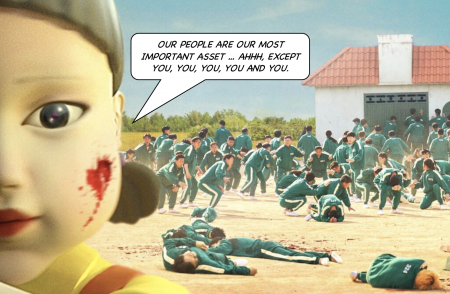Reduction in force

|
Reduction in force
rɪˈdʌkʃən ɪn fɔːs (n.)
The permanent removal of headcount — mass redundancy — usually targeted at that sweet spot in the organisation whose own reports aren’t so useless they can’t get by without supervision by someone who genuinely knows what is going on, and who aren’t so senior that they get to make decisions about who should be subject to a RIF. Usually, therefore, it is a means of taking out a swathe of mid-ranking subject matter experts.
Line management
A word about line management: a modern corporation is organised like an inverted, multilayer family tree, tracing back to great, great, great, great grandfather Hank.
Everyone, bar Hank, has at least one line manager.
Fortunate staff have only one line manager: les miserables also have a “dotted line” into someone else. This is a bit like having an open relationship, or an affair with a distant uncle.
But we digress.
The basic job of line management is to supervise direct reports. Employees all have things to do besides supervising their direct reports, though a given worker’s proportion of line management to other stuff depends on that employee’s seniority.
Roles change in three key ways the higher up the multi-level marketing scheme you go:
You get paid more: The more senior you are, the more lolly you take home. This is not news that will not rock anyone’s world. Nor that the rate of increase is not linear, but exponential. This stands to reason: There are many, many Belarusians taking home 30,000 rubles, and ten executive board members taking five million a piece.
- the proportion of your time spent on line management increases — we take this to be a trivial observation: the contractor at the call centre in Belarus has no direct reports, so soends no time managing; the CEO ultimately has every direct report, so does almost nothing but line managing.
- the purpose of your upward line management shifts: the Belarusian contractor who arrived from the job-centre in Minsk in knows nothing: his interaction with his manager is almost completely substantive, functional and necessary: the chief operating officer has been at the firm forty years, knows its every idiosyncracy and foible; her interaction with her live manager is almost entirely formal: when she presents issues to her boss she should know the answers as well as her boss will